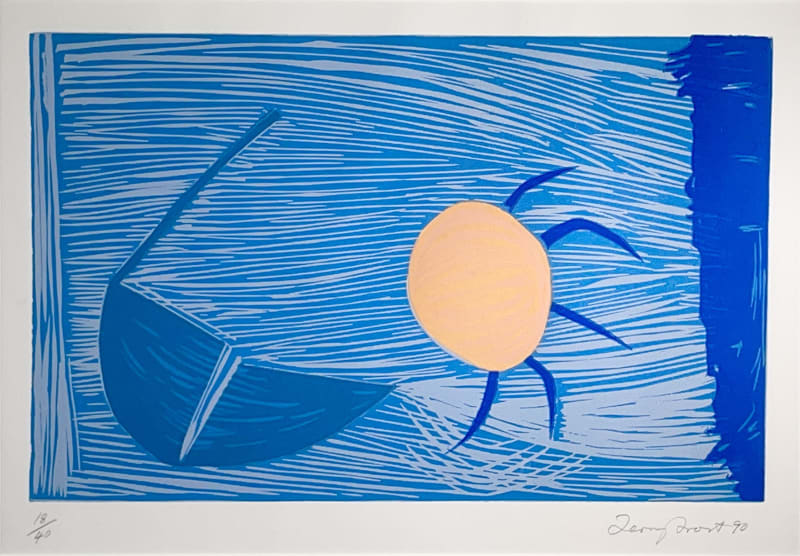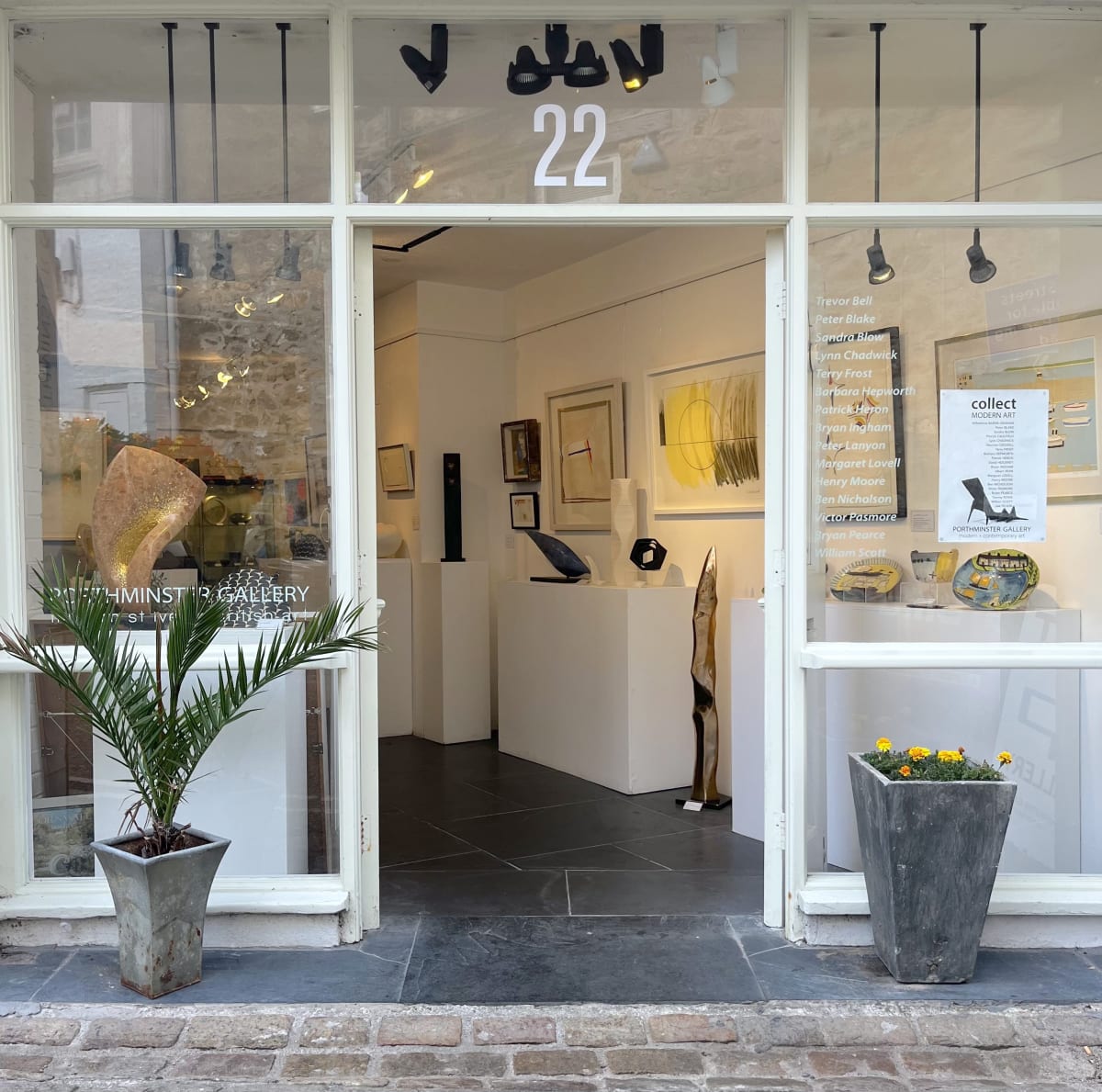Terry Frost RA English, 1915-2003
-
 Terry Frost RALong Bow (Kemp 176), 1998Silkscreen print with collage elements on Arches paper with full margins.Signed and dated Terry Frost 98 (lower right), numbered from the edition of 50 (lower left).Image: 27.5 x 87 cm.
Terry Frost RALong Bow (Kemp 176), 1998Silkscreen print with collage elements on Arches paper with full margins.Signed and dated Terry Frost 98 (lower right), numbered from the edition of 50 (lower left).Image: 27.5 x 87 cm.
Sheet: 50 x 108 cm.
Frame: 58 x 105 cm.Edition number 38 of 50View more details -
 Terry Frost RAOrange Sun Newlyn (Kemp 206), 2000Silkscreen printed in colours on Velin Arches paper with full margins.Signed and numbered from the edition of 100 in pencil.Sheet: 63.5 cm x 51 cm (25 x 20 in.)
Terry Frost RAOrange Sun Newlyn (Kemp 206), 2000Silkscreen printed in colours on Velin Arches paper with full margins.Signed and numbered from the edition of 100 in pencil.Sheet: 63.5 cm x 51 cm (25 x 20 in.)
Number 48 from the edition of 100View more details -
 Terry Frost RAUntitled 08 (Kemp 117), 1989/90Linocut printed on Zerkall 225gsm paper.Signed, dated, and numbered from the edition of 40 in pencil.Image: 30.5 cm x 48 cm (12 x 19 in.)
Terry Frost RAUntitled 08 (Kemp 117), 1989/90Linocut printed on Zerkall 225gsm paper.Signed, dated, and numbered from the edition of 40 in pencil.Image: 30.5 cm x 48 cm (12 x 19 in.)
Sheet: 55 cm x 64.5 cm (21 3/4 x 25 1/2 in.)
Frame: 57.5 x 72.5 x 3.5 cm (22 1/2 x 28 1/2 x 1 1/2 in.)Number 18 from the edition of 40, aside from 5 APsView more details
‘‘A circle means so much to me; it’s become like a god. I can use it in any colour I want, and often I use it in black, because I think a black sun is beautiful.’’
Born in Leamington Spa in 1915, Frost started painting in 1941 as a prisoner of war in Bavaria. On his return to Britain Frost moved to St Ives in Cornwall, to be amongst the burgeoning artistic community there. His work reflects the inspiration he found in the Cornish light, glittering seas and watery reflections.
Frost worked as Barbara Hepworth’s assistant in 1951 and had his first solo exhibition at the Leicester Galleries in 1952. He was awarded the John Moore’s Prize in 1965, elected to the Royal Academy in 1992 and knighted in 1998.
Sir Terry Frost took his inspiration from nature; the sun, moon, water, boats and the female form are recurring motifs in the works here on show. Abstracted into sensuous circles and curves, dramatically coloured in blues, reds, oranges, yellows and black, Frost believed that the interplay of colour and shape could realise an event or image more successfully than imitation.
His works are held in many public and private collections worldwide, including: Tate Gallery, London; Victoria and Albert Museum, London; National Gallery of Canada; and National Gallery of New South Wales, Australia.
-

WHERE ROCKS BECOME SEA | Autumn–Winter Show
4 Nov 2023 - 6 Jan 2024Gallery show of contemporary art for sale, featuring new paintings by artists Sara Dudman, Masako Tobita, and ceramics by Peter Hayes, Charlotte Jones, Mitch Pilkington, Antonia Salmon, Paul Wearing, and prints by Melvyn Evans and Trevor Price, and sculptures by Tommy Rowe and Michael Thacker. With supporting works by leading 20th Century modern artists: Terry Frost, Barbara Hepworth, Victor Pasmore and Joe Tilson. Artworks also available for sale by St Ives and British Artists: Wilhelmina BARNS-GRAHAM, Peter BLAKE, Sandra BLOW, Patrick CAULFIELD, Lynn CHADWICK, Maurice COCKRILL, Terry FROST, Barbara HEPWORTH, Patrick HERON, David HOCKNEY, Bryan INGHAM, Albert IRVIN, Margaret LOVELL, Henry MOORE, Ben NICHOLSON, Victor PASMORE, Bryan PEARCE, Tommy ROWE, William SCOTT, Joe TILSON.Read more -

COLLECT | MODERN ART
9 Sep - 4 Nov 2023Gallery exhibition of Modern St Ives and British art for sale, featuring art – paintings, prints, drawings, and sculptures – by leading 20th Century artists, including: Wilhelmina BARNS-GRAHAM, Peter BLAKE, Sandra BLOW, Patrick CAULFIELD, Lynn CHADWICK, Maurice COCKRILL, Terry FROST, Barbara HEPWORTH, Patrick HERON, David HOCKNEY, Bryan INGHAM, Albert IRVIN, Margaret LOVELL, Henry MOORE, Ben NICHOLSON, Victor PASMORE, Bryan PEARCE, Tommy ROWE, William SCOTT, Joe TILSON.Read more -

COLLECT: MODERN ART
Exhibition of original art by leading 20th Century St Ives & British Artists 12 Mar - 30 Apr 2021Our annual selling exhibition of original art by leading 20th Century St Ives and British Artists, provides exciting opportunities for new and seasoned collectors alike. With the boost in growth of the Modern British Art market during the 2020 lockdown, the award-winning Porthminster Gallery in St Ives presents this curated...Read more -

RELOCATION
11 Sep - 24 Oct 2020The opening collection at our new premises at 22 Fore Street is a changing showcase of artworks by some of the many established and emerging British Artists whom we represent, along with collectable works by major Modern St Ives and British names.Read more -

TERRY FROST PRINTS
9 Feb - 23 Mar 2019Celebrating the rich abstraction of the celebrated St Ives artist's work with a selling exhibition of vibrant collectable signed silkscreen prints by this great British modern master.Read more -

Collect | Modern St Ives + British Art
21 May - 25 Jun 2016A specially curated selling exhibition of collectable artworks by major St Ives and British names. The exhibition will also feature new sculptures by Margaret Lovell and Peter Hayes, and paintings by Matthew Lanyon.Read more











